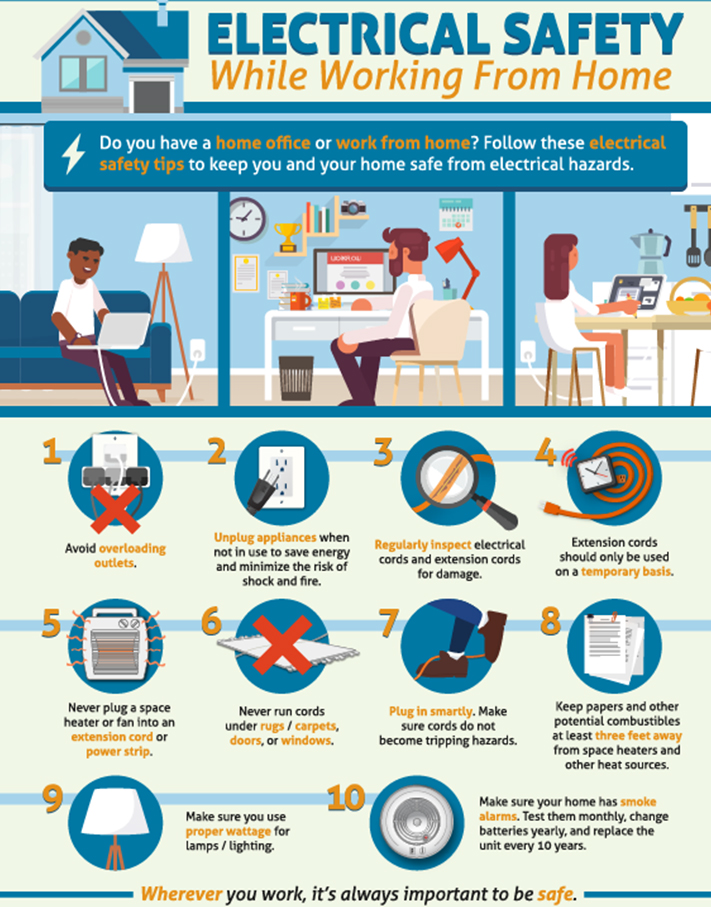Safety Tips
- Inspect appliances regularly for faulty or damaged plugs, switches and cords and replace them or have them repaired immediately.
- If you do throw them away, make sure they can’t be used by anyone else.
- Switch off and unplug appliances before cleaning them.
- Never poke anything into an appliance such as a toaster.
- Never touch an appliance with wet hands.
Cords are how we connect our appliances to the power supply and these too need to be treated with care. Safety tips for electrical cords include the following:
- Extension cords should only be used as a temporary solution and should be placed around walls to prevent tripping, and never under rugs or carpet.
- Always remove a cord from the wall at the plug, as pulling on the cord itself is unsafe.
- Only use extension cords outside that are rated for outdoor use and make sure the connections are protected from the weather.
- Fully unwind cords before use to prevent overheating.
In response to our client request, we considered to expand our technical business to a big level and established CHRONELO TECHNICAL SERVICES in 2019. Here at Chronelo, we are providing a wide range of services including testing and tagging, portable appliance testing, RCD testing and so on. Our technicians are experts in their fields and strictly work under the Australian safety regulations. We want to make sure that you and your family live and work in a safe environment. After all every life matters.



PREVENTION
As with most dangers, the best form of protection is prevention and you can drastically reduce the risk of electrical accidents by observing these few simple rules:
- Never attempt DIY electrical work. It is illegal and can lead to electrocution or fires. Always use a licensed electrician.
- Replace old ceramic wire-type fuses with switch-type circuit breakers.
- Test safety switches every three months to ensure they are in good working order.
- Have safety switches or RCDs (Residual Current Devices) installed. In an emergency, they will cut power flow in one thousandth of a second, preventing electrocution.
- Have a licensed electrician do an electrical safety audit of your home or business to identify possible dangers.
While electricity does have the potential to kill, there is no reason why we can’t live safely around it. As long as we exercise common sense and teach our kids to do the same, electricity can continue to be a powerful ally in every aspect of our lives.
WHS REGULATIONS
In 2011, Safe Work Australia developed a single set of WHS laws to be implemented across Australia. These are known as ‘model’ laws. For the model WHS laws to become legally binding, the Commonwealth, states and territories must separately implement them as their own laws.
We are responsible for maintaining the model WHS laws, but we don’t regulate or enforce them.
The Model WHS laws include:
- the model WHS acts
- the model WHS regulations
- model code of practice.
These elements are supported by the national compliance and enforcement policy, which sets out principles of how WHS regulators monitor and enforce compliance with their jurisdictions’ WHS laws.
WHS regulators in the Commonwealth and in each state and territory are responsible for regulating and enforcing the laws in their jurisdictions. The model WHS laws have been implemented in the Australian Capital Territory, New South Wales, the Northern Territory, Queensland, South Australia, Tasmania and the Commonwealth. Some jurisdictions have made minor variations to make sure the legislation is consistent with their relevant drafting protocols and other laws and processes.
For information on the operation of WHS laws in your jurisdiction, please contact your WHS regulator..
These elements are supported by the national compliance and enforcement policy, which sets out principles of how WHS regulators monitor and enforce compliance with their jurisdictions’ WHS laws.
Model WHS Act
The Model WHS act forms the basis of the WHS Acts that have been implemented in most jurisdictions across Australia.
The main object of the Act is to provide for a balanced and nationally consistent framework to secure the health and safety of workers and workplaces. It does this by:
- protecting workers and other persons from harm by requiring duty holders to eliminate or armoniz risk
- providing for fair and effective representation, consultation and cooperation
- encouraging unions and employer organisations to take a constructive role in promoting improvements in WHS practices
- promoting the provision of advice, information, education and training for WHS
- securing compliance with the Act through effective and appropriate compliance and enforcement measures
- ensuring appropriate scrutiny and review of actions taken by persons with powers or functions under the Act
- providing a framework for continuous improvement
- maintaining and strengthening national armonization of WHS laws and facilitating a consistent national approach to.
SOURCE: SAFE WORK AUSTRALIA
